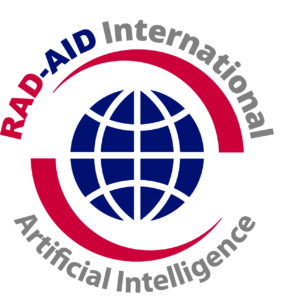 RAD-AID manages a rapidly growing portfolio of Artificial Intelligence (AI) tools (thanks to generous partners contributing software) for helping low-resource hospitals to learn and potentially use AI for increasing and improving clinical patient care. AI is generally defined as software that learns from data inputs to generate progressively improved outputs (in contrast to older software models that could only perform tasks pre-programmed into the code).
RAD-AID manages a rapidly growing portfolio of Artificial Intelligence (AI) tools (thanks to generous partners contributing software) for helping low-resource hospitals to learn and potentially use AI for increasing and improving clinical patient care. AI is generally defined as software that learns from data inputs to generate progressively improved outputs (in contrast to older software models that could only perform tasks pre-programmed into the code).
Why Radiology and AI Go Together
Radiology AI is at the forefront of HealthCare AI because radiology’s images are data-rich and provide fertile ground for AI platforms to learn and produce radiologic tasks such as the automated interpretation of x-ray, MRI, CT, mammograms, and ultrasound images, as well as software based image-quality assessments and patient-care workflow triage. Read RAD-AID AI strategies in LMICs, recently published in Radiology.

Director of RAD-AID Peru, John Scheel, MD, PhD, teaching and volunteering in Cusco, Peru, including AI education.
Why AI is important in global health
AI has the potential to bring great benefits to resource-poor hospitals where there are significant shortages of medical professionals. For example, Kenya has 4-5 million women needing yearly mammograms, however, there are fewer than three fellowship trained breast radiologists in Kenya, which in the US would require over 500 radiologists to perform this level of screening. Could AI help that under-resourced breast cancer service by automating some of the image-interpretation in new screening programs? Could AI also help automate emergency head CT reads for intracranial bleeds or help interpret chest x-ray radiographs for Tuberculosis (TB) and infectious outbreaks? Currently available AI technologies are not rolled out (yet) for such high-volume clinical roles, but the field is filled with scientists, companies, laboratories and organizations actively developing platforms to carry out these roles.
Challenges for AI in Global Health
Although there are great potential benefits to AI in low-resource regions, there are also significant risks and challenges. For example, AI that is created based on datasets from high-income countries may not be applicable in low-resource regions among demographic and social groups that are different from the source. This challenge refers to the data diversity problem stemming from healthcare disparity. It is also unclear how scarce radiologists in low-income countries will use the outputs of AI if there is little local prior experience with these technologies or limited clinical experience with these types of interpretations.
Can such AI outputs be trusted by local radiology professionals to guide patient care in low-resource settings? Data from resource-poor hospitals may also be unavailable for training new AI (or validating AI from an outside location) due to government regulatory restrictions and resource-constraints, and many low-resource hospitals still do not have computers, cloud structures, and IT networks for receiving, learning, and implementing AI. Solutions also need to safeguard patient privacy and data confidentiality, for which local frameworks are still in development.

Clinical education for local human capacity development is key for sustainable progress; RAD-AID radiologist volunteer in Guyana
Our AI Strategy
Facing these opportunities and challenges for Global Health AI in low-resource settings, RAD-AID has a strategy for helping hospitals participate in the ongoing wave of radiology AI innovation. Our first step is to provide on-site clinical training to improve the conventional clinical resources that these hospitals can use for patient care. This means teaching x-ray, CT, MRI, ultrasound, interventional, and molecular imaging in efforts to build in-country experience and knowledge, which is an essential foundation for providing good patient care now and supervising AI applications in the future.
Second, RAD-AID supports infrastructure such as implementing radiology equipment, cloud storage, and IT networks, including Picture Archiving and Communications Systems (PACS).
Third, RAD-AID introduces AI tools in a supportive educational, and vendor-neutral context so that hospitals can adjust to AI in medical imaging workflows and learn how to use AI for their patients in a methodical and incremental approach. We use our TEACH-TRY-USE strategy so that we teach basic AI concepts (what is validation, generalizability, performance-metrics, domain shift, etc.), then have hospitals try out AI in limited nonclinical pilots for appraising AI’s efficacy, safety, efficiency, etc., and then use the AI in gradual workflows.
This combination of clinical education, infrastructure, and AI enables RAD-AID to offer a balanced growth plan for using AI effectively in low and middle-income countries. If you are interested in RAD-AID’s AI program, volunteer now for our many programs. We welcome health professionals of all backgrounds since AI will interface healthcare across a wide range of contexts. You will join interdisciplinary teams of physicians, technologists, nurses, IT specialists and public health advocates so that AI can bring positive change to medically underserved communities.